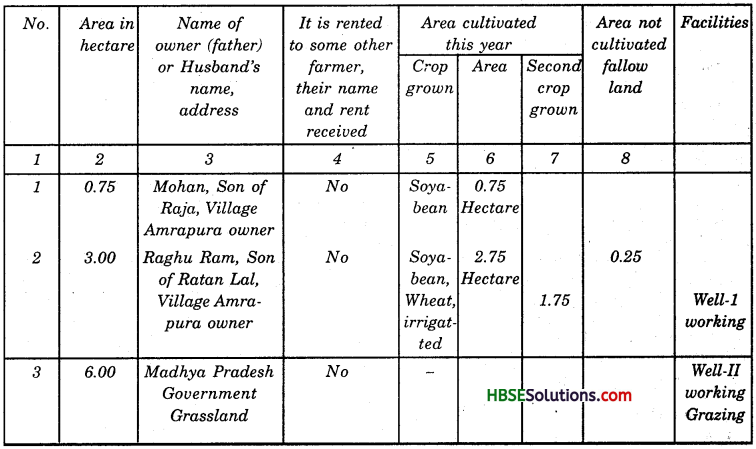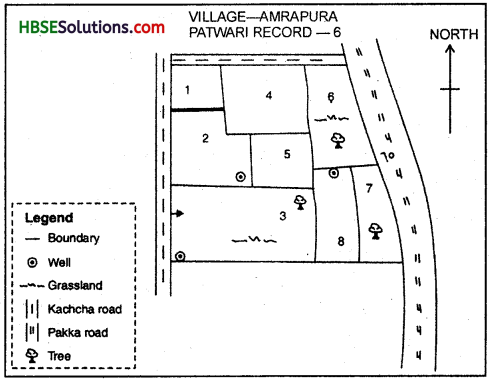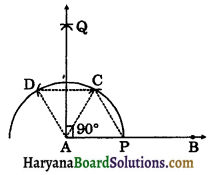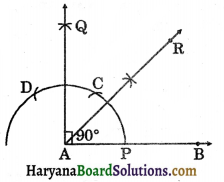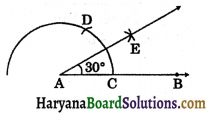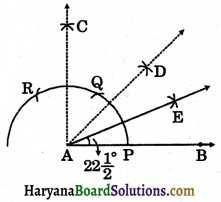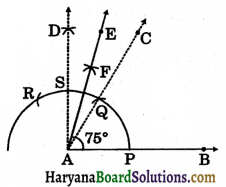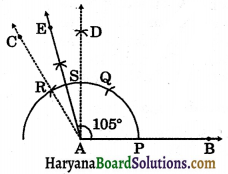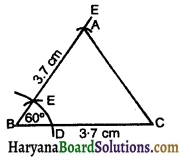Haryana State Board HBSE 7th Class English Solutions Honeycomb Chapter 4 The Ashes that Made Trees Bloom Textbook Exercise Questions and Answers.
Haryana Board 7th Class English Solutions Honeycomb Chapter 4 The Ashes that Made Trees Bloom
HBSE 7th Class English The Ashes that Made Trees Bloom Textbook Questions and Answers
Comprehension Check
The Ashes that Made Trees Bloom Question Answers HBSE 7th Class Question 1.
Why did the neighbours kill the dog?
Answer:
The neighbours were very angry with the dog as it did not guide them to the treasure so the neighbours killed the dog.
The Ashes that Made Trees Bloom HBSE 7th Class Question 2.
Mark the right item.
(i) The old farmer and his wife loved the dog
(a) because it helped them in their day-today work.
(b) as if it was their own baby.
(c) as they were kind to all living beings.
Answer:
(b) as if it was their own baby.
(ii) When the old couple became rich, they
(a) gave the dog better food.
(b) invited their greedy neighbours to a feast.
(c) lived comfortably and were generous towards their poor neighbours.
Answer:
(c) lived comfortably and were generous towards their poor neighbours.

(iii) The greedy couple borrowed the mill and the mortar to make
(a) rice pastry and bean sauce.
(b) magic ash to win rewards.
(c) a pile of gold.
Answer:
(c) a pile of gold.
Working With The Text
Answer the following questions.
Question 1.
The old farmer is a kind person. What evidence of his kindness do you find in the first two paragraphs.
Answer:
Old farmer was a kind person. Having no children, they loved it as though it were a baby. The kind people fed the pet With hitbits of fish from their own chopsticks and it was allowed to have all the boiled rice it wanted.
Question 2.
What did the dog to lead the farmer to the hidden gold?
Answer:
One day dog came running to the old man. He tried to motion him to some spot behind. The dog kept on running to and for some minutes. The old man followed the dog to the place where dog was scratching. When the old man struck his loe in the earth was surprised to find a pile of gold gleaming before him.
Question 3.
(i) How did the spirit of the dog help the farmer first?
(ii) How did it help him next?
Answer:
(i) The spirit of the dog appeared to him in a dream and asked him to cut down the pine tree over his grave. He asked him to make morter for his rice pastry and a mill for bean sauce. When the old made the dough ready for baking, it turned into a heap of gold coins.
(ii) Next spirit of the dog told the old couple that how the wicked people had burned the mill made from the pine tree. He told them that they should sprinikle the ashes of the withered trees. This would make the tress bloom.
Question 4.
Why did the daimio reward the farmer but punish his neighbour for the same act?
Answer:
When Daimio’s palanquin drew neal the old man scattered pinch of ash over the tree. The tree burst into blossom. Daimo stopped the train and ordered presents of silk robes, sponge-cake, fans to be given to him.
The greedy neighbour repeated the same act. When the sprinkled handful of ashes, the wind blew the line dust. All them pomp of spoiled. The wicked old man was beaten to death.

HBSE 7th Class English The Ashes that Made Trees Bloom Important Questions and Answers
Very Short Answer Type Questions
Question 1.
Why did the old couple love their dog so much?
Answer:
They loved the dog so much because they did not have any baby of their own and loved it as if it were a baby.
Question 2.
How did they treat their pet animals?
Answer:
They made cushion of blue crepe and fed the pet with titbits of fish from their own chopstick.
Question 3.
How did the dog protect his master?
Answer:
The dog followed him to work and walked in the footsteps of the old men to pick up the worms.
Question 4.
How did the dog react when he wanted to take the couple to treasure?
Answer:
The dog kept on motioning his head to some spot behind and kept on whinning to and fro.
Question 5.
How did the wicked couple behave with the dogs?
Answer:
The wicked couple always kicked the dogs whenever they passed their house.
Question 6.
What did the couple wicked couple find when he began to dig with a hoe?
Answer:
They found nothing but dead kitten, the smell of which made them drop their tools.
Question 7.
What things did the owner of the dog keep with the grave of the dog?
Answer:
The owner of the dog kept a cup of water, a tray of food and sticks of incense.

Question 8.
What dream did the kind couple have about the dog?
Answer:
The kind couple dreamt that they should cut down the pine tree and make a mortar for his rice pastry.
Question 9.
What happened when wicked man began to pound?
Answer:
When the wicked man began to pound, the pastry and sauce turned into a foul mass of worms.
Question 10.
What happened when the kind couple sprinkled a pinch of ash?
Answer:
A pinch of ash sprouted blossoms until it became a cloud of pink blooms which perfumed the air.
Question 11.
How did the people behave when the loyal people passed by?
Answer:
When the loyal people passed by, the people fill upon hands and knees. They remained in prostrate position.
Question 12.
What did daimio give the kind old man?
Answer:
Daimio gave present of silk robés, sponge-cake, fans and other rewards.

Short Answer Type Questions
Question 1.
How did the kind man treat the dog?
Answer:
The kind man loved the dog as if it were a baby. They made it a cushion of blue crepe.
They gave him to eat all the boiled rice and titbits of fish. They protected the dumb creature like to be with down soul.
Question 2.
How did the dog repay the kind man for the kindness?
Answer:
The dog loved the kind man a lot. The dog followed him to work and kept near by. 11e protected the old man by picking up the worms smell which made them drop their tools and beat the dog to death. They threw him into the earth and put earth over him.
Question 4.
How did the owner of the dog mourn the death of the dog?
Answer:
When the owner of the dog heard of the death of his pet dog, he mourned sticks as if it had been their own child. lie set bamboo nebes in the ground. He put fresh camellia flowers. He laid a cup of water and tray of food on the grave. He called him by many names. That same night the spirit of the dog appeared to them. He told them to make mortar from rice pastry and mill for bean sauce.
Question 5.
What two things did spirit of the dog show them?
Answer:
The dog was buried, he appeared before them and said cut down the pine tree over his head. He asked them to make a mortar for his rice pastry and a mill for his bean sauce. Long after that the good old man dreamed again and spirit of dog spoke to him. He told them to take the ashes of the mill and sprinkle them on the withered trees. Then trees will bloom again.
Question 6.
Wliat was the custom in days of daimios?
Answer:
In the days of daimios, it was a custom that when lord passed by, all the loyal people shut up the second-storyed windows. All the people would fall upon their hands and knees. The people remained in prostrate until the procession passed by.

Some Other Questions For Examination
Question 1.
Why did the old man at first not pay attention to the pet dog’s actions of putting his paws against his legs?
Answer:
The old man at first did not pay attention to the pet dog’s actions as he thought he was playing.
Question 2.
Why did the old couple love their dog so much?
Answer:
They loved the dog so much because they did not have any baby of their own and loved it as if it were a baby.
Question 3.
How did the people behave when the loyal people passed by?
Answer:
When the loyal people passed by, the people fell upon their hands and knees and remained prostrate until the procession passed by.
Question 4.
Write the character sketch of old kind couple.
Answer:
The old kind couple led a simple life. They had no child so they treated their dog with great care. They loved him and fed him properly. They were not greedy. When they found the treasure, they helped their poor neighbours. They were friendly. They arranged a feast also for their friends. They did everything in a proper manner. They kept every essential thing near the grave of the dog. The old farmer was very emotional. When the pet dog died, he shed tears and called him by names as if the dog were alive.
The loss was unbearable for him.
Question 5.
What two things did spirit of the dog show them?
Answer:
The dog was buried, he appeared before them and said cut down the pine tree over his head. He asked them to make a mortar for his rice pastry and a mill for his bean sauce. Long after that the good old man dreamed again and spirit of dog spoke to him. He told them to take the ashes of the mill and sprinkle them on the withered trees. Then trees will bloom again.

Question 6.
Write the character-sketch of the wieked old neighbours.
Answer:
The wicked old neighbours were not good at heart. They kept an eye into what was happening at their neighbour’s place. They were greedy. When they got to know about the treasure the old couple got, they fed the dog with fish and danties. When after scratching the ground, they got a dead kitten. Being angry, they killed the dog.
Next time, they borrowed the mill from the old couple to get gold. They began to grind but their pastry and sauce turned into worms. They broke the mill into pieces. The greedy neighbour sprinkled ashes on the diamio like the old farmer. However, his ashes did not burst into blossom like the ashes of the old farmer. The ash entered the noses and eyes of the daimio and his wife. The old neighbour was beaten to death. He was duly punished.
Multiple Choice Questions
Tick (✓) the correct answer.
Question 1.
How did the wicked couple behave with the dogs?
(а) They kicked the dogs whenever they passed their house.
(b) They fed them with milk and bread.
(c) They beat them sticks whenever they passed their house.
(d) None of these.
Answer:
(а) They kicked the dogs whenever they passed their house. ✓
Question 2.
What things did the owner of the dog keep with the grave of the dog?
(a) a cup of water
(b) a tray of food
(c) sticks of incense
(d) all of these
Answer:
(d) all of these ✓
Question 3.
Under what tree did the old couple make the grave of their pet dog?
(a) mango tree
(b) pine tree
(c) cherry tree
(d) eucalyptus tree
Answer:
(b) pine tree ✓

Question 4.
How were the neighbours of the old kind couple?
(a) very helpful
(b) kind
(c) wicked and jealous
(d) faithful
Answer:
(c) wicked and jealous ✓
Question 5.
What was the name of the pet dog?
(a) Mike
(b) Miko
(c) Muko
(d) Juko
Answer:
(c) Muko ✓
Question 6.
Which of the following statements is incorrect?
(a) The wicked couple were happy with the neighbour’s good luck.
(b) When the owner of the dog heard the death of his pet dog, he mourned as if it has been their own child.
(c) The people remained in prostrate until the procession passed by.
(d) None of these.
Answer:
(a) The wicked couple were happy with the neighbour’s good luck. ✓
Make Sentences
Make sentences of your own with the following words:
1. Patient
2. Furious
3. Pretended
4. Burst into
5. Scattered
6. Competent
Answer:
1. Patient: One has to be a very patient listener in order to learn something.
2. Furious: The old gentleman got furious over his son’s dishonest behaviour.
3. Pretended: Rajesh pretended to be sick when he did not want to go to school.
4. Burst into: The children burst into laughter when they saw the actions of the clown in the circus.
5. Scattered: The peasant’s wife scattered the grains onto the field to let them dry.
6. Competent: My father is competent enough to start a lavish business.

The Ashes that Made Trees Bloom Passages for Comprehension
Read the following passages carefully and answer the questions that follow:
Passage-1
The old ……………….. any cat.
Questions:
(i) Who is ‘it’?
(ii) How did they take care of ‘it’?
(Hi) Wliat was given ‘it’ to wear?
(iv) How did it show ‘regard’?
Answers:
(i) It is pet little dog of the couple.
{ii) They fed the pet with titbits of fish and allowed to have all the boiled rice.
(iii) It was given cushion of blue crepe.
(iv) ‘It’ showed regard by protecting the couple with a soul.
Passage – 2
One day ……………….. some minutes.
Questions:
(i) Who is the ‘doggy’?
(ii) What was found in the spot behind?
(Hi) What did the old man think would be found in the spot?
(iv) Choose a word which means ‘movement’.
Answers:
(i) The doggy is the pet of the couple.
(ii) Pile of gold was found in the spot behind.
(iii) The old man thought that some titbits of buried bone or fish would be found.
(iv) Motioning.

Passage – 3
Hearing of ……………. nor move.
Questions:
(i) What good luck neighbours had given through?
(ii) What treasure they were hoping to find?
(iii) How was dog forced to reveal the truth?
(iv) How did dog react to the action of the cruel pair?
Answers:
(i) The neighbours had been blessed with pile of gold.
(ii) They were hoping to have good luck and get gold.
(iii) Bits of fish and dainties were served up before the dog.
(iv) The dog stopped eating or moving.
Passage – 4
Furious at his carcass.
Questions:
(i) Why were they furious at the dog?
(ii) Who is the old man?
(iii) How did they treat the dog?
(iv) Choose a word which means ‘dead body‘.
Answers:
(i) They were furious at the dog for not guiding them to find a treasure.
(ii) The old man is the greedy neighbour of kind couple.
(iii) They beat the dog to death and threw him into the hole.
(iv) Carcass.
Passage – 5
That night ………………. bean sauce.”
Questions:
(i) What does ‘that night’ refer to?
(ii) What does the appearance of spirit of dog show?
(iii) How does even the spirit show concern for the couple?
(iv) Choose a word which means ‘burial place’.
Answers:
(i) That night refers to the night when the greedy old couple killed the dog.
(ii) The appearance of the spirit of dog shows that dog is greatly concerned for the couple.
(iii) Even the spirit tells the couple that how mortar can be cut down from the pine tree.
(iv) Grave.

The Ashes that Made Trees Bloom Translation in Hindi
1. In the ………………….. any cat.
डैमोस के समृद्ध काल में, एक बूढ़ा दंपत्ति रहता था जिन के पास एक छोटा पालतू कुत्ता था वह संतानहीन थे इसलिए उसे ऐसे प्यार करते थे जैसे कि उनका अपना बच्चा हो। बूढ़े डेम ने नीले कपड़े की तकिया बनाई और खाते समय मुको चुपचाप एक बिल्ली की तरह शांत बैठ जाता था।
Word Meaning: Couple-pair = दंपत्ति, Cushion-comfortable and stuffed = तकिया, Demure-silent = शांत।
2. The kind ……………………………. a soul.
वे दयालु लोग उस पालतू कुत्ते को मछली के टुकड़े अपने हाथों से खिलाते थे। इसलिए वह गूंगा प्राणी उसके रक्षकों को आत्मा की तरह प्यारा था।
Word Meaning: Titbits-small pieces = टुकड़े, Treated behave = व्यवहार, Dumb-notable to speak = गूंगा, Creatures-living objects = जीवित वस्तु. Protectors-those who save other = रक्षक, Soul-inner conscience = आत्मा।
3. Now the ………………………. the hills.
अब वह बूढ़ा आदमी, चावल का किसान हर रोज फावड़े के साथ खेतों में जाता था। वह काले कौए की पहली कांव-कांव की आवाज से तब तक काम करता रहता जब तक कि सूरज डूबन जाता।
Word Meaning: Raven-black crow heit = कोआ, Croak-toutter such a sound = कांव-कांव की आवाजा
4. Every day ……………………. the birds.
हर रोज उसका कुत्ता उसके साथ काम पर जाता और साथ रहता था। वह कभी भी सफेद बगुले को नुकसान नहीं पहुंचाता था जो कि बूढ़े आदमी के कदमों में कीड़े-मकोड़े उठाने आ जाता था। वह बूढ़ा आदमी हर जीव के साथ दयालुता का व्यवहार करता था। वह चिड़ियों को खाना देने के लिए धरती को तृण भूमि में बदल देता था।
Word Meaning: Heron-a long-legged wading bird = बगुला, Worms small insects = कीड़े-मकोड़े. Fellow-person = व्यक्ति, Sod-upper Layer of grass = तृण भूमि।
5. One day ………………….. some minutes.
एक दिन कुत्ता उसकी तरफ दौड़ता हुआ आया, अपने पंजे उसकी टाँगों के बीच में रखते हुए और उसने अपने सिर से पीछे की तरफ इशारा किया। बूढ़े आदमी ने सोचा कि उसका पालतू जानवर सिर्फ खेल रहा है अतः ध्यान नहीं दिया। पर कुत्ता कुछ पल के लिए कराहता रहा और आगे-पीछे दौड़ता रहा।
Word Meaning: Motioning-movement = संकेत, Whinning-toutteracry of pain = कराहना।

6. Then the ………………………. before him.
तब बूढ़े आदमी ने उस कुते का कुछ कदम पीछा किया जहाँ पर वह कुत्ता जमीन खुरेचने लगा। उसने सोचा कि शायद कोई हड्डी या कुछ मछली का टुकड़ा होगा। पर अपने पालतू जानवर को खुश करने के लिए बूढ़े आदमी ने धरती को कुदाली से खोदा। वह देखकर आश्चर्यचकित रह गया कि उसके सामने सोने का ढेर चमक रहा था।
Word Meaning: Scratching–mark of seratching: खुरेचना, Yard-A few steps = गज, Buried-kept deep under earth = दबा हुआ, Humor-make happy = खुश करना, lloe-tool for digging = कुदाली. Gleamed-shine = चमकना।
7. Thus in ……………………. with kindness.
कुछ ही पल में बूढ़े दपत्ति अमीर बन गए । आर्दश दंपत्ति ने भूमि का टुकड़ा खरीदा, दोस्तों को दावत दी और गरीय पड़ोसियों को बहुत दान दिया। कुत्ते के साथ भी उन्होंने दयालुता का व्यवहार किया।
Word Meaning: Couple-husband-wife = दमपति, Soul essential pari = आदर्श, Feast-dinner = दावत| Plentiful-a lot = बहुत. Petted-loved = प्यार करना, Kindness-love= दयालुता।।
8. Now in …………………………. nor move.
उसी गाँव में एक दुष्ट बूढ़ा दंपत्ति रहता था जो हमेशा घर | के सामने से निकलने वाले कुत्तों को ठोकर मारते और डाँटते रहते।
अपने पड़ोसियों की अच्छी किस्मत के बारे में सुनने पर उन्होंने कुत्तों को बगीचे के अन्दर मछली के टुकड़े और दूसरी अच्छी चीजें रखकर बहलाने लगे। उनको आशा थी कि वह उनके लिए खजाना |ढूँढ कर देगा। पर कुत्ते उस दुष्ट दंपत्ति के डर से न तो हिलते थे – और न ही खाते थे।
Word Meaning: Wicked-cruel = दुष्ट, Scolded-to rebuke = डाँटना.Coaxed-to entice = बहलाना, dainties-delicacy = विशेष भोजन, Hoping-expect = आशा, Treasure-valued object = खजाना।
9. Then they ……………………. lay beneath.
“Quick, wife, ………………………… with joy.
तब वह उसे घर से बाहर घसीट कर ले गए। उनके हाथ में फावड़ा और कुदाली थी। चीड़ के पेड़ के पास पहुँचते ही कुत्ता अपने पंजे से भूमि को खरोचने लगा। जैसे कि भूमि के नीचे विशाल खजाना दबा पड़ा है।
“मेरी पत्नी मुझे जल्दी से फावड़ा और कुदाली दो!” लालची मूर्ख बूढा खुशी से नाचते हुए चिल्लाया।
Word Meaning: Dragged-to take forcefully = घसीटना, Spade-Tool for digging = फावड़ा, Treasure-Something of value-खजाना।
10. Then the……………………. his carcass.
तब लालची बूढा फावड़े और कुदाली के साथ खोदने लगा पर उसे एक मरी हुई बिल्ली के अलावा और कुछ न मिला जिसकी बदबू के कारण उनको अपनी नाक बंद करके अपने औजार फेंकने पड़े। कुत्ते पर क्रोधित होकर, बूढ़े आदमी ने ठोकर मारी और उसे जान से मार दिया। बूढ़ी औरत ने अपना काम खत्म करने के लिए कुत्ते का सिर तेज कुदाली से काट दिया। तब उसने उसकी लाश को गड्ढे में डाल दिया और उस पर मिट्टी का ढेर बना दिया।
Word Meaning: Furious-violent – क्रोधित. Chopping-to cut off = काटना, Flung-To throtu = फेंकना, leaped-to pile = ढेर बना दिया, Careass-dead body = लाश।

11. The owner ……………camellia flowers.
कुत्ते के मालिक ने पालतू कुत्ते की मौत के बारे में सुना और उसके लिए ऐसे शोक मनाया जैसे कि उनका अपना बेटा हो। वह रात को चीड़ के पेड़ के नीचे चले गए। उसने कुछ बाँस के डडों को धरती पर लगाया जिस तरह के मकबरों पर लगाए जाते हैं। उसमें उसने ताजे कैमिला के फूल लगाए।
Word Meaning: Owner-who owns things = मालिक, Mourning-to grieve over death of someone = शोक, Bamboo-a kind of grass = बाँस, Fresh-blooming = ताजे।
12. Then he……………………… were alive.
तब उसने पानी का कप और खाने की ट्रे को मजार पर रख दिया और कई महँगी अगरबत्ती जलाई। उसने अपने पालतू कुत्ते के मरने पर शोक मनाया और उसको ऐसे प्यारे नामों से बुलाया जैसे कि वह जीवित हो।
Word Meaning: Costly-expensive = महंगी, Mourned to grieve = शोक मनाना।
13. That night ………………… bean sauce.”
उस रात कुत्ते की आत्मा उसके सामने स्वप्न में आई और उसने कहा “मेरी कत्र के उपर लगा चीड़ का पेड़ काट दो और चावल की पेस्ट्री बनाने के लिए इसमें से इमामदस्ता बना सकते हो और अपनी फली की सॉस के लिए चक्की बना सकते हो।”
Word Meaning: Spirit-soul = आत्मा, Appeared-to came before = सामने प्रकट होना, Mortar-a vesel for pounding = अखल, इमामदस्ता
14.So the……………………. pounding rice.
इसलिए, बूढ़े आदमी ने पेड़ काट दिया और पेड़ के बीच के तने से दो फुट लम्बा हिस्सा निकाला। बड़ी मेहनत से कुछ आग द्वारा और कुछ औजार से उसने एक कटोरे की तरह खोखली जगह बनाई। उसने तब एक लम्बा लकड़ी के हैंडल का हथौड़ा लिया जैसा कि चावल पीसने में प्रयोग किया जाता है।
Word Meaning: Chopped-to cut = काटना, Trunk-stem of a tree = पेड़ का तना, Scraped-removed = निकालना, Hollow-deep cut = खोखला, Pounding-grinding = पीसना।
15. When New ……………………. like rain.
जब नव वर्ष का समय आया तो उसने चावल की पेस्ट्री बनाने की सोची। जब चावल सारा उबल गया तो दादी ने उसको पीसने के लिए डाल दिया। बूढ़े आदमी ने उस मिश्रण को आटे में बदलने के लिए हथौड़ा उठाया और इतने भारी और तेज झटके लगे कि पेस्ट्री पकाने को तैयार हो गई। अचानक पूरा मिश्रण सोने के सिक्कों में बदल गया। जब बूढ़ी औरत ने चक्की में सेम की सांस डालकर पीसनी शुरू की तो सोना वर्षा की तरह गिरने लगा।
Word Meaning: Wished hoped = आशा, Mortar-a vesel for pounding = अखल, बर्तन, Pound-to grind = पीसना, Dough-paste of rice = गुंधा हुआ आटा. Ileap-pile = ढेर, Grind to turn to powder = पीसना।
16. Meanwhile the…………. being ground. ‘Goody me” …………. I will.”
इसी बीच ईर्ष्यालु पड़ोसी ने खिड़की से झांका जब उबली हुई फलियों को पीसा जा रहा था।
“ओह !” बढ़ा दम्पति चिल्लाया जैसे ही उसने गिरती चटनी को पीले सोने में बदलते देखा तक कुछ ही मिनटों में पीसने वाली मशीन के नीचे चमकते हुए सोने का टब पड़ा था। “मैं उस मशीन को उधार लूंगा। मैं ऐसा करूँगा।”
Word Meaning: Envious-jealous = ईष्यालु, Peeped-to look through = झाँकना, Dripping-falling drop by drop – एक-एक बूंद करके गिरना,: Borrow-to ask from other for some time = उधार लेना।
17. So the ……………………….. as firewood.
अत: बूढ़ा दंपत्ति फिर से अमीर हो गया। अगले दिल कृपण और दुष्ट पड़ोसी ने फलियों को उबाला और इमामदस्ता और जादूवाली मशीन उधार ली। उन्होंने एक को उबले चावलों से भरा और दूसरे में फलियाँ भर दी। तब बूढ़ा आदमी कूटने लगा और औरत पीसने लगी। पर पहली ही चोट और घुमाने पर, पेस्ट्री और सॉस कीड़े-मकोड़े के सड़े हुए मिश्रण में बदल गई। इस पर नाराज होकर उन्होंने मशीन को जलाने के लिए छोटे-छोटे टुकड़ों में काट डाला।
Word Meaning: Couple-husband and wife = दंपत्ति, Stingy-miser = कंजूस, Wicked-cruel = दुष्ट, Miss-mixed up = मिलाना, Borrowed-to ask from other = उधार मांगना, foul-bad smell = दुर्गन्ध, Chopped-cut into pieces = छोटे टुकड़ों में काटना।
18. Not long ………………………. dog-spirit.
कुछ ही समय बाद अच्छे बूढ़े आदमी ने फिर से स्वप्न देखा और कुत्ते की आत्मा ने उससे बात की। उसने बताया कि दुष्ट व्यक्ति ने चीड़ के पेड़ से बनी मशीन को जला दिया है। मशीन | की राख को लेकर सूखे पेड़ों पर छिड़क दो और वे दुबारा से खिल जाएँगें कुत्ते की आत्मा ने कहा।
Word Meaning: Wicked-sinful = दुष्ट, Ashes-burnt particles left over = राखा, Sprinkle-to spray = छिड़काव, Withered-dry = सूखा, Bloom-to open up as a flower = खिलना।
19. The old …………………. broken pieces.
बूढ़ा आदमी उठा और एकदम दुष्ट पड़ोसी के घर गया, जहाँ पर दुखी बूढ़ा दंपत्ति चौकड़ी मारकर आग के पास बैठा था। वह फर्श के बीच में बैठे धूम्रपान कर रहा था और सूत कात रहा था। हर थोड़े समय के अन्तराल में वह अपने हाथों और पैरों को आग की लौ से सेक रहे थे जो कि मशीन के टुकड़ों से उत्पन्न हो रही थी। और उनके पीछे टूटे हुए टुकड़े पड़े थे।
Word Meaning: Wicked-sinful = दुष्ट, Miserable-sad = उदास, Spinning-to spin = कातना, Blaze-flame of fire = आग की लपट, Pile-one over other = ढेर।

20. The good ……………………… the ashes.
दयालु बूढ़े दम्पति ने राख के लिए भीख माँगी, जबकि लालची दंपत्ति ने अपनी नाक सिकोड़ ली और ऐसे डाँटने लगे जैसे वह चोर हो। उन्होंने उसे राख से टोकरी भरने दी।
Word Meaning: Humbly-modestly = नम्रतापूर्वक, Covetous-very desirous = लालची, Scolded to rebuke = झिड़कना ।।
21.On coming ………………….the wonder.
घर पहुंचने पर बूढ़ा व्यक्ति अपनी पत्नी को बगीचे में ले गया। सर्दी के मौसम के कारण उनका प्रिय चैरी का पेड़ सूना था। उसने चुटकी भर राख उस पर छिड़क दी, और ओह! वह गुलाबी बादलों की तरह पुष्प पुंज में खिल गया और हवा में सुगन्ध फैल गई। यह खबर सारे गाँव में फैल गई और सब लोग इस अद्भुत दृश्य को देखने के लिए दौड़ पड़े।
Word Meaning: Favourite-like above others – प्रिय, Bare-not covered = नंगा, सूना Sprinkled-to scatter in small drops – छिड़का, Sprouted-to germinate = उत्पन्न होना, Blossoms-flower bud – पुष्पपुंज, Perfumed_scented = खुशबू, Wonder-surprised = अद्भुत।
22. The covetous…………… trees blossom.
जब उस लालची दंपत्ति ने कहानी सुनी तब बची हुई चक्की की राख को इकट्ठा किया और उसे सूखे पेड़ों को पुन: खिलने के लिए रख लिया।
23. The kind ……………………the wayside.
उस दयालु बूढ़े आदमी ने सुना कि उसका स्वामी डैमियो गाँव की ऊँची सड़क पर से गुजर रहा था, वह हाथ में राख की टोकरी लेकर उसको देखने गया। जैसे ही गाड़ी पास आई वह रास्ते में सूखे चैरी के पेड़ के ऊपर चढ़ गया।
Word Meaning: Lord-sovereign =स्वामी, Approached-come near= पास आना, Withered-dry = सूखा, Wayside-on the way = रास्ते में ।
24. Now, in …………………….. passed by.
डैमियो के दिनों में यह रिवाज था कि जब भी स्वामी वहाँ से गुजरता तो लोग अपनी दूसरी मंजिल की खिड़कियाँ बन्द कर देते। वह खिड़कियों को कागज के टुकड़े से चिपका लेते ताकि वह स्वामी पर देखने की अशिष्टता न कर बैठें। सब लोग सड़क पर साष्टांग दंडवत की स्थिति में तब तक रहते जब तक जुलूस निकल नहीं जाता।
Word Meaning: Pasted-to bolt = चिपकाना, Commit-to do = करना। Impertinence-uneivilily = अशिष्टता। Prostrate-lying on round facing downward = दंडवत् करना, Processionorderly succession = जुलूस।
25. The train ………………….. was passing.
गाड़ी पास आई। एक लम्बा व्यक्ति कदम से कदम मिलाता आगे बढ़ा। वह रास्ते में चीखते हुए बढ़ रहा था,”अपने घुटनों पर झुक जाओ! अपने घुटनों पर झुक जाओ!” और जुलूस के निकलते समय सब झुक गए।
Word Meaning: Marched-to move in regular manner = कदम से कदम मिला कर चलना, Kneeled-to bent your knees = घुटने झुकाना।

26. Suddenly the ……………. into blossom.
अचानक वैन के नेता की नजर पेड़ पर बैठे बूढ़े आदमी पर पड़ गई। वह उसे गुस्से से बुलाने ही वाला था पर जब उसने देखा कि वह इतना बूढ़ा है, उसने ऐसा दर्शाया कि जैसे उसने उसकी तरफ ध्यान नहीं दिया और वहाँ से निकल गया। और जब डैमियो की पालकी वहाँ पास आ गई तो बूढ़े व्यक्ति ने एक चुटकी राख टोकरी से निकालकर पेड़ पर फैला दी। कुछ ही पल में वह खिल गया।
Word Meaning: Sight-scene = दृश्य, Pretended-to show = दिखाना, Palanquin-a covered letter carried by four men = पालकी, Scattered-to spread = फैलाना।
27. The delighted ………………… his castle.
आनंदित डैमियो ने गाड़ी को रोकने का आदेश दिया और हैरानी से बाहर देखा। उसने बूढ़े आदमी को बुलाते हुए धन्यवाद किया और सिल्क के कपड़े, स्पंज-केक, पंखे और अन्य इनाम देने का आदेश दिया। यहाँ तक कि उसने उसे अपने महल में भी बुलाया।
Word Meaning: Delighted-to please highly = आनन्दित, Robes-gowns = कपड़, Rewards-gift = इनाम, Castle-a big building = महला
28. So the …………………………… old wife.
But when ……………………….. cherry tree,
अत: बूढ़ा आदमी अपने घर गया, अपनी पत्नी से प्यार बाँटने।
पर जब लालची पड़ोसी ने यह सब सुना, तब वह कुछ जादू की राख लेकर राजमार्ग पर चल पड़ा। वह तब तक इंतजार करता रहा जब तक डैमियो की गाड़ी न आ गई और झुंड की तरह घुटने टेककर, वह सूखे चैरी के पेड़ पर चढ़ गया।
Word Meaning: Gleefully-happily = खुशीपूर्वक, Instead-in place of = के बदले में Kneeling-In a bent = घुटने टेककर, Withered-dry position = सूखे, Highway-main road = राजमार्ग।
29. When the……………….the procession.
जब डैमियो स्वयं उसके ठीक नीचे आया, तो उसने मुट्ठीभर राख .पेड़ पर फेंकी जिसने एक भी चीज को नहीं बदला। हवा द्वारा रेत के कण डैमियो और उसकी पत्नी की नाक आँखों तक पहुंच गए। छीकें और दमघोंटू। इससे जुलूस की सारी शान-शौकल बिगड़ गईं।
Word Meaning: Sneezing-to make explosive sound while emitting air from the nose छींकना. Choking-to suffocate = दम घुटना, Pomp-show off = fearai, Dignity-respectable = शान-शौकता
30. The man …………………………. for dead.
Thus the ……………………………… old age.
वह आदमी जिसका कार्य था, उससे कहा गया, “अपने घुटनों के बल उतरकर नीचे आओ,” पेड़ से खींचा और उसे राख की टोकरी के साथ गड्ढे में ढकेल दिया। फिर उसे अच्छी तरह मारने के बाद, मृत की तरह छोड़ दिया गया।
इस प्रकार वह दुष्ट बूढ़ा आदमी रेत में दब गया, पर उस कुत्ते का दयालु दोस्त अन्त तक अपनी पत्नी के साथ सुख-शांति से अपना बुढ़ापा गुजारने लगा।
The Ashes that Made Trees Bloom Summary in English
In the good days of daimios there live an old couple whose only pet was a little dog. They took great care of the pet. The pet also protected them from everything. Their kindness guided them to treasure. They found a pile of gold. Their wicked Nighbours were very jealous. They forced the dog to guide them to treasure. On not finding it, they killed him.
The owner of the dog heard of the death of the pet. They mourned over it. The spirit of the dog appeared to him and told them ways to get rich. The old man followed the instructions. The wicked neighbour also tried to do the same. But they could not become rich rather their ground paste turned into worms.
Once again the dog in its dream told them to sprinkle the ashes of the burnt mill. The ashes made the trees bloom. This news made all the people fill with wonder. The kind old man heard that his lord the Daimlo was to pass. Although it was the custom than no one should commit the mistake of the looking down on his lordship. Suddenly when the old man sprinkled some ashes on the Palanquin it burst into a blossom. The old man was rewarded.
The greedy neighour out of jealousy tried the same but made all the people sneeze and choke. The greedy couple was beaten to death. The kind couple lived peacefully till green old age.

The Ashes that Made Trees Bloom Summary in Hindi
डैमोस के समृद्ध काल में एक बूढ़ा दम्पति रहता था जिनके पास एक पालतू कुत्ता था। वह उस पालतू कुत्ते का बहुत ध्यान रखते थे। वह भी उन्हें हर चीज से बचा कर रखता था। उनका दयालु व्यवहार उन्हें खजाने की तरफ ले गया। उन्हें सोने का एक ढेर मिला। दुष्ट पड़ोसियों को बहुत ईर्ष्या हुई। उन्होंने कुत्ते को खजाने का रास्ता दिखाने के लिए विवश किया। खजाना न पाने पर उसे मार दिया।
कुत्ते के मालिक को उसकी मौत के बारे में पता लगा। उन्होंने इस पर शोक मनाया। कुत्ते की आत्मा उनके स्वप्न में आई और उन्हें अमीर बनने के तरीके बताए। बूढ़े आदमी ने हिदायतों का पालन किया। दुष्ट पड़ोसी ने भी ऐसा करने की कोशिश की। दुष्ट पड़ोसी अमीर न बन पाए बल्कि उनकी पेस्ट कीड़ो में बदल गई।
एक बार पुनः कुत्ते की आत्मा ने स्वप्न में बताया कि जली हुई लकड़ी की राख का चीड़ के पेड़ पर छिड़काव कर दो। उस राख से पेड़ खिल गए। इस खबर से सारे लोग आश्चर्यचकित रह गए।
उस दयालु बूढ़े व्यक्ति ने सुना कि उनका राजा डैमोस वहाँ से गुजर रहा था। रिवाज के अनुसार से कोई भी राजा को उपर से देखने की गलती नहीं कर सकता था, पर उस व्यक्ति ने जैसे ही ऊपर से राख पालकी पर छिड़की तो एक दिन फूल खिल गए। उसे इनाम दिए गए। लालची पड़ोसी ने भी ईर्ष्या में ऐसा किया पर सब लोग छींकने लगे और उनका दम घुटने लगा। उस लालची दंपत्ति को मौत के घाट उतार दिया गया। वह दयालु दंपत्ति लम्बे समय तक शांतिपूर्वक जीवन निर्वाह करते रहे।
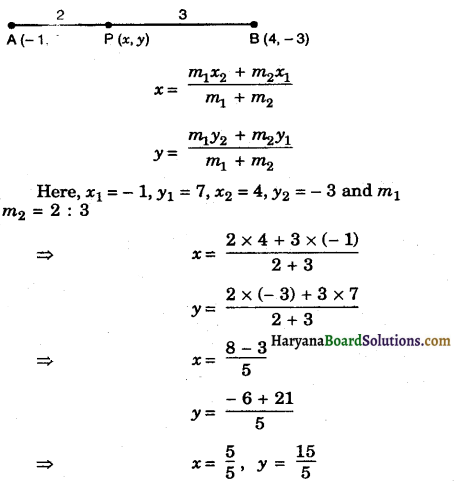
![]()

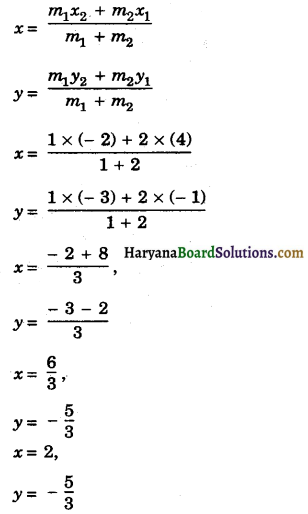
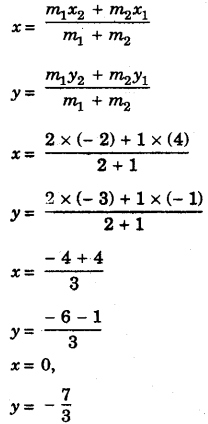
![]()
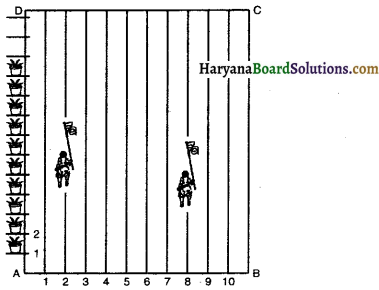
![]()
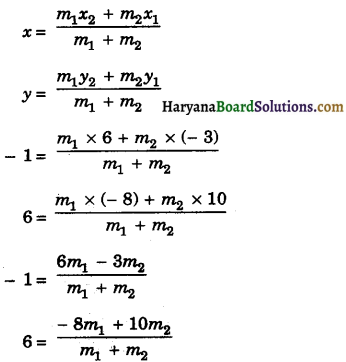
![]()
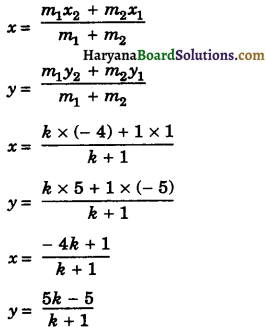
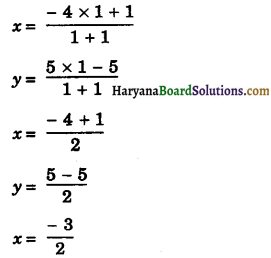
![]()
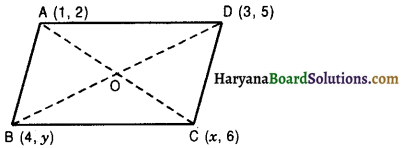
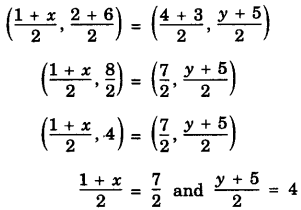
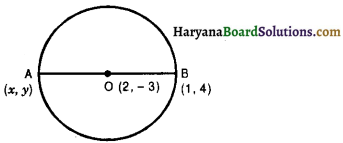
![]()
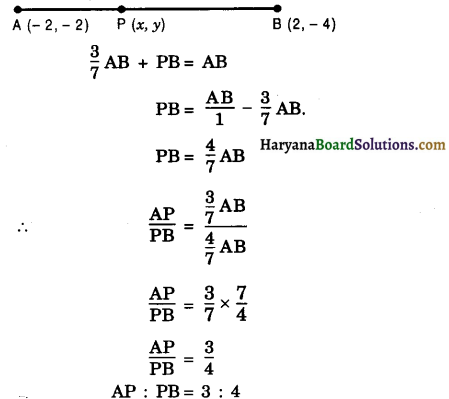
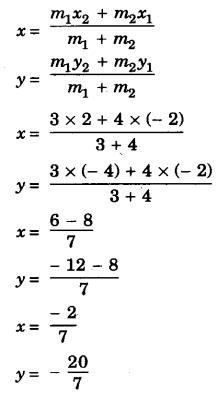
![]()


![]()
